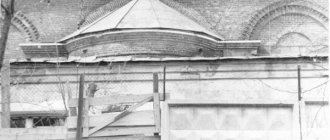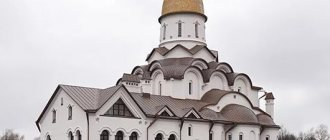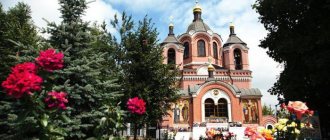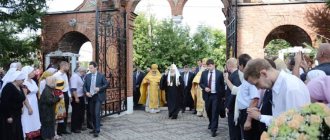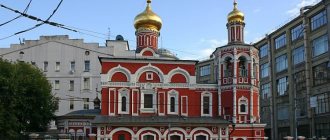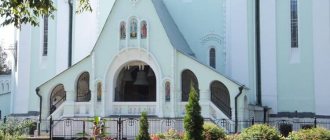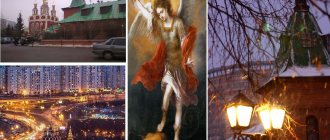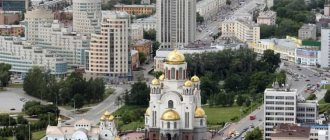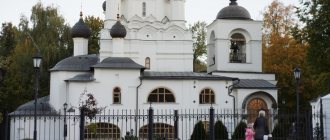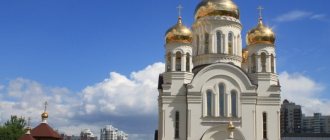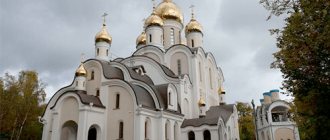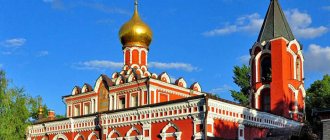Zyuzino is one of the districts of Moscow, located in the South-Western administrative district of the capital. The history of this area dates back to the 13th century. During all this time, the small village passed from one hand to another, even becoming the property of the noblewoman Morozova.
In the 19th century, it was used as a summer residence for employees of Moscow University; a little later, the main estate was demolished, and country houses were built in its place.
Zyuzino became part of the capital only in the 60s of the past, and appeared in modern maps of the capital in 1995. There is an opinion that the area received this name in honor of one of the owners of this area with the surname Zyuzin. Today this area is often visited by residents of the capital and guests, and all because of the ancient temple of Boris and Gleb.
Historical events
The first saints in Rus' who deserved people's love and respect were the passion-bearing princes Boris and Gleb. More than one temple was built in their honor, but one of them is located in Zyuzino.
Boris and Gleb are two brothers, whose father was none other than Prince Vladimir himself. It was precisely by the example of their father, who was an unbridled pagan, and later became a meek servant of Christ, that the brothers grew up obedient and God-fearing. When the brothers became adults, their father sent them to reign in Rostov and Murom.
When Prince Vladimir was already in old age, the Pechenegs attacked Rus'. He could not lead the army himself, so he instructed his son Boris to repel the enemy. When Boris was on a campaign, his father died, and his place on the throne was taken by his elder brother Svyatopolk, who planned to destroy his brothers. The murder was committed in the 11th century.
The two sons of Prince Vladimir, Gleb and Boris, became the first Russian saints. They were canonized as martyrs-passion-bearers. They became intercessors of the Russian land and assistants to the princes of Rus' in heaven.
The temple was founded back in the 17th century. Construction was very difficult, which is why it dragged on for 20 years. The lower temple was built very quickly, but difficulties arose with the upper one and it was possible to consecrate it after the lower one only after sixteen years. But this is not all the difficulties, when the construction was managed to be sorted out, the temple encountered another misfortune - Bolshevism.
It was during this period that the peasants broke down the doors and carried out all the valuables, and the wooden parts were chopped into pieces and used as firewood.
USSR period
The temple in Zyuzino of Boris and Gleb survived the era of Soviet atheism with not the greatest losses. It was officially closed in 1938. Unfortunately, after closing, the temple was robbed - the carved iconostasis, preserved from the day the church was founded, was chopped up for firewood.
For a long time, the temple in Zyuzino of Boris and Gleb was empty. 20 years later, when the bell tower began to collapse and the building became very dilapidated, its restoration began, after which a diamond processing workshop was created in its premises. Gem cutters worked in the building for almost 20 years.
Another 20 years later, in the late 70s, a new restoration began. Now it was decided to place an archive of documents from the Ministry of Tool and Machine Tool Industry of the Soviet Union here, but it existed here for a relatively short time. In the late 80s, the territory of the USSR began to allow the professing of religious beliefs, and many churches and temples began to function according to their intended purpose again. The temple in Zyuzino of Boris and Gleb was consecrated again in 1989. As during its creation, the lower temple was restored first, and the upper one a little later. It opened its doors to parishioners only in 1990.
Architecture, appearance
The construction of the Temple of Boris and Gleb in Zyuzino began at the end of the 17th century and it took more than 15 years to build. This unique structure is over 300 years old. It was built with his own savings by an associate of Peter I, Prince B.I. Prozorovsky.
Previously, these lands belonged to the noblewoman Morozova. But after the Old Believer split, the lands were donated by Peter Prozorovsky. And the prince decided to build a temple on these lands.
Yakov Bukhvostov was chosen as the architect of the temple. It was thanks to him that a new style in architecture appeared in Moscow at that time - Moscow or Naryshkin baroque. The temple in Zyuzino became the prototype of many other temples in the capital.
But it has one unique feature - the apse of the altar is turned to the north. This was the condition of Prozorovsky, who wanted the apse to look strictly at the central part of the capital.
The temple of Boris and Gleb in Zyuzino has two floors: the lower one, or as it is often called, the winter one, was erected in honor of Prince Vladimir, and the upper one, the summer one, in honor of his sons.
The building is placed on a high basement with an open arch, and columns are placed above its pillars. Above the central part of the building you can see a wide octagon framed in the form of a decorative scallop, and above it there is a bell tower. The external decoration of the temple is very modest than that of similar buildings in the capital.
But the lack of some details is compensated by the presence of rich ornate staircases leading to the upper temple. Entering the upper temple, it seems that the visitor is rushing upward, but in the lower one it is much more cramped and lower.
In the 30s of the last century, this temple, like many others in Russia, was closed.
Before the church was closed during Soviet times, two wonderful abbots served there. Until 1937, Alexander Kharyuzov served in the service, who was arrested and then shot, and his place was taken by none other than his brother Leonid, who was prophesied to serve God for a short time, and that’s exactly what happened - he suffered the fate of his brother.
Until the end of the 80s of the last century, the temple was closed.
In 40-41, the building was left without security, which allowed attackers to break into the doors and destroy all the wooden parts: the sharp iconostasis, frames, doors. The bell tower was also destroyed. Miraculously, the Royal Doors, a small part of the icons and carved columns were preserved. Today all this can be seen in the Kolomenskoye Museum.
During the time that the temple was closed, the building was not used: vegetables were stored in it, during the war the bell tower was used as an observation tower, after which it was a workshop for a precious metals factory. During the time that the temple was not used for its intended purpose, it was severely damaged.
50 years after the closure of the temple, it was again open to parishioners and the first divine service took place there (May 15, 1989) in memory of the holy martyrs Boris and Gleb. Parishioners were not allowed into the temple itself; reconstruction was going on there, but the service was held on the street. But 2 months later the first liturgy took place in the lower church.
Moscow. Church of Boris and Gleb in Zyuzin
Built in 1688-1704. (architect Yakov Bukhvostov) in the estate of an associate of Peter I, boyar B.I. Prozorovsky, the village of Zyuzine, which after that became known as Borisovskoye. The lower, warm church with the throne of the holy noble princes Boris and Gleb was consecrated in 1688.
, the upper one with the throne of St. Equal-to-the-Apostles Prince Vladimir - in 1704 and the side chapel of St. Nicholas the Wonderworker - in 1690). In 1879, a bell tower was added and a clergy house was built. In the Moscow Baroque style, two-story, three-domed.
The building is rectangular in plan, on a high basement, with two staircases. Above it are two octagonal tiers (the upper one is the ringing tier - “like bells”) and chapters crowned with an octagonal drum.
Adjacent to the main building on the sides are a quadrangular (with corners cut off from the outside) altar ledge and a vestibule, completed with domes. Decorated with arched niches, three-quarter columns and figured ridges.
note
In 1938 it was closed, looted and abandoned. The carved iconostasis in the Moscow Baroque style was lost. The four-pillar bell tower with an open belfry was destroyed. Rebuilt as warehouses, it was occupied by institutions, a workshop, and an archive. In the 1960s and since 1979 it has been restored (architect K.G. Polunina). In July 1989, services were resumed. The shrine is the especially revered Tikhvin Icon of the Mother of God.
https://russian-church.ru/viewpage.php?cat=moscow&page=197
A two-story temple “like bells” (that is, with a tier of ringing crowning the building), built in 1688 in the “Moscow Baroque” style by boyar B. Prozorovsky (architect Yakov Bukhvostov). The Lower Warm Church was consecrated in 1688 in honor of St. equal to book
Vladimir, the upper church - in 1704 in honor of St. bgg. knn. Boris and Gleb. The idea is simple and profound: the feat of the holy passion-bearers Princes Boris and Gleb was nurtured (prepared) by their father, the holy Equal-to-the-Apostles Prince Vladimir.
The bell tower was added in 1879.
The temple building is brick, cruciform in plan on an arched basement. Staircases on arches adjoin the temple from the west and south.
In the 19th century, the state commission classified the temple as an architectural monument and mentioned it as a valuable monument of icon painting and interior decoration.
This is confirmed by the fact that the model of the temple is exhibited in the Central Archaeological Cabinet at the Moscow Theological Academy in the Trinity-Sergius Lavra.
In difficult times for the faith, the last two priests of the temple performed the feat of confession: the father and son of the Kharyuzovs. On September 14, 1937, Fr. Alexander Kharyuzov (executed on January 9, 1938). Despite death threats, his son, Priest Nikolai Kharyuzov, took his place. In November, authorities arrested him and sentenced him to 10 years in labor camp. ABOUT.
Interior decoration
The Church of Boris and Gleb in Zyuzino was completely redesigned from the inside. The iconostasis is new, but made according to the sketches of the old one and is almost identical to what was here originally. All the painting on the walls is new; besides, the temple was not painted from the inside until the 19th century. The thing is that the problem with the painting was an engineering error.
Yakov Bukhvostov, who built the temple from scratch, was a famous architect, but during the construction of the temple he did not take into account a very important point - the weather conditions of the Russian winter.
When the decision was made to re-paint the temple, the question arose in what style the interior decoration should be done. If the temple itself was built in the Moscow Baroque style, then the interior should be in the same direction. But when they began to look for artists with sketches of future decoration, it turned out that this style was long in the past and no one uses it anymore.
Afterwards, they began to select styles that would fit at least a little and settled on Byzantine. It was this kind of decoration that was best suited for the times of the lives of Saints Boris and Gleb.
On the western wall of the upper church you can see the fresco of the Transfiguration of the Lord, and on the southern wall - the Assumption of the Virgin Mary. In the temple you can see the most revered icons, including the icon of the Mother of God and the most important one - the Joy of All Who Sorrow.
Also in the temple there is an icon of the Blessed Virgin Mary. More than a hundred years ago, this icon was donated to the temple by the governor himself. The icon is quite old with yats and ers; there is an inscription on its reverse side, dated January 3, 1895.
Also in the upper church there is an attached altar of St. Nicholas the Wonderworker, an icon of St. Nicholas with a reliquary and an icon of the Great Martyr Panteleimon.
In the lower church you can see the throne of Prince Vladimir and a fresco that was dedicated to the Baptism of Rus'. And on the fresco of the New Martyrs and Confessors of Russia you can see Emperor Nicholas II and his entire family.
Architecture
The temple was built in the Moscow Baroque style and in appearance is very similar to the temple in Trinity-Lykovo, which, according to some sources, was created by the architect Ya. Bukhvostov. Experts say that the Church of Saints Boris and Gleb may also be his work.
The external decoration of the church is more modest than that of other contemporaries. But the lack of some decorative details is compensated by two rich and ornate staircases that lead to the upper temple.
The upper temple immediately creates an upward tendency, while the lower one is much lower and more crowded.
Shrines
When the temple was being restored, the abbots of Moscow churches presented shrines as gifts to the church. One of them was the icon of the great martyr and healer Panteleimon. She turned out to be so miraculous that after entering the temple she cleansed herself and was renewed, delighting the parishioners with her renewed face.
The Calvary Cross was also presented as a gift - this is a magnificent and unique thing. Also, ordinary parishioners donated their personal icons to the church, and all the others were re-painted by the master and today are considered prayed for.
These include:
- icon of St. Nicholas the Wonderworker with a reliquary;
- Most Holy Theotokos of Tikhvin;
- Matrona of Moscow;
- Joy to all who mourn;
- Inexhaustible Chalice;
- Xenia of Petersburg;
- Spyridon of Trimifuntsky.
Mosaic icon “Boris and Gleb” on the facade of the Temple of Boris and Gleb in Zyuzino
Some icons located in the temple were painted at the request of parishioners. One of the icons, the Sign, was in the temple at the beginning of the 20th century, and after it was closed, one of the parishioners kept it and returned it to the temple after its opening.
Also in the temple there is an icon of the Helper in Childbirth, to which pregnant women come, asking for a safe and easy birth.
Temple in Zyuzino of Boris and Gleb: history, events, modernity
In the Moscow district of Zyuzino, in the southwest of the capital, there is a small but remarkable Church of Boris and Gleb. It is located on a quiet street, but many people know about it and often come here.
This temple has a very long and interesting history.
Today the church has many problems, but, despite all the difficulties, the clergy works hard and continues the work begun several centuries ago, when the first stone of the new sanctuary was laid.
Construction of the Church of Saints Boris and Gleb in Zyuzino began at the end of the 17th century - the first works date back to 1688. Construction lasted almost 20 years and was completed in 1704.
Initially, of course, it was not an area of a large modern metropolis, but a small village that belonged to the noble princely family of the Prozorovskys.
These princes are descendants of the Yaroslavl Rurikovichs, the first princes of Rus'.
Interesting facts and legends
Why is the temple named specifically martyrs-passion-bearers? Gleb and Boris, two siblings, were killed by their older brother Svyatopolk, who was popularly called the Damned. The brothers voluntarily accepted their death, knowing in advance that they were to be killed. The brothers did not even think of raising their hands against their older brother.
The whole point is that an integral part of the Christian faith - non-resistance to evil through violence - was a wonder for pagan Rus', which had just adopted Orthodoxy.
Svyatopolk, who killed his brothers, himself fled to Poland, and all his life he could not find a place for himself. There is a legend that even from the grave where Svyatopolk was buried, a stench emanated. But the two brothers Gleb and Boris became the patrons and guardians of Rus'.
Opening hours and schedule of services
The temple in the small Moscow district of Zyuzino, erected in honor of the passion-bearers Boris and Gleb, is open every day from 8 to 22. On the night from Saturday to Sunday, the church doors are not closed.
The schedule of services is described in the table below.
| Monday Friday | In the morning at 8 o'clock the liturgy of St. John the Theologian, and at 5 p.m. Vespers and Matins. |
| Saturday | In the morning at 8.00 the liturgy of St. John the Theologian. At 17.00 all-night vigil. |
| Sunday | At 8.00 Liturgy of St. John the Theologian, at 17.00 vespers, matins. |
You can find out about services on holidays on the official website of the church or by calling.
The temple employees, as well as its rector, are active in social activities. For about 10 years now, the church has been running a Sunday school, which can be attended by both adults and children.
The temple has its own website, where everyone can see the latest photos of various events taking place within the walls of the temple. The staff is always ready to help those who need it and answer all questions from parishioners.
The temple regularly hosts events for children and adults: reading fairy tales, various master classes. The church regularly organizes collections of things, which are then distributed to the poor and needy.
Sunday school teachers regularly hold meetings with students from other educational institutions. And the parish missionary school regularly organizes trips to the most beautiful and ancient places in the city and beyond.
Sights and shrines of the Temple of Boris and Gleb in Zyuzino
I enjoy visiting churches when traveling, especially ones that have an interesting history.
The seemingly unremarkable and ordinary Church of the Holy Martyrs Boris and Gleb in Moscow Zyuzino is definitely worth attracting pilgrims to, because it is interesting not only from the point of view of performing rituals close to every believer, but also for its architecture, as well as historical vicissitudes. I sincerely advise all Muscovites and guests of the capital to visit this wonderful temple, attend the service and become imbued with the spirit of our church.
Where is the temple
- Moscow, st. Perekopskaya, 7.
- Contact phone: 8 (499) 1228410.
- If you do not live in Zyuzino, take the metro to Kakhovskaya or Sevastopolskaya .
- Then you need to take trolleybus No. 72 or No. 60 or minibus No. 826 and go to the Youth Center .
- As soon as you leave, look around: the temple will be right in front of you.
The temple is open from 8:00 to 22:00 on all days except holidays.
The church is not closed on the night from Saturday to Sunday.
Schedule of services of the Church of Boris and Gleb
Monday Friday:
- 8:00 – Morning hours. Liturgy of St. John the Theologian.
- 17:00 – Vespers. Matins.
Saturday:
- 8:00 – Morning hours. Liturgy of St. John the Theologian.
- 17:00 – All-night vigil.
Sunday:
- 8:00 – Morning hours. Liturgy of St. John the Theologian.
- 17:00 – Vespers. Matins.
History of the creation of the temple
- It was laid back in the distant 17th century by order of Boris Prozorovsky, one of the closest associates of Peter I.
- It is assumed that the authorship of the temple's design belongs to the most famous Moscow Baroque architect, Yakov Bukhvostov , which makes it one of the most interesting examples of architecture from the time of Peter the Great.
- It is known that construction was difficult - while the lower (winter) temple was consecrated in 1688, the upper one received blessing only in 1704.
- Having happily passed all the tests, the bright temple faced another misfortune - Bolshevism, when distraught peasants broke out and took out the most valuable iconostasis, and then chopped it up for firewood. Alexander Kharyuzov, was arrested and subsequently shot . Despite threats and fear of reprisals, his place was taken by his son, Nikolai Kharyuzov, who was also eventually arrested and sent into exile. After this, the temple was closed, the new owners remodeled the unique interiors and redesigned the premises.
- At first, the church housed a vegetable warehouse, and then a branch of a precious metals factory, whose management installed a galvanic bath in the altar of the gradually collapsing lower church.
- In May 1989 , when the temple was finally returned to people, the building was in very poor condition. Despite this, already in July a divine liturgy took place in the church, the first after many years of obscurantism, which gave a new beginning to the ancient building.
- Today, almost thirty years later, the Church of Boris and Gleb has been completely restored and is ready to welcome believers from all over our country.
Photo of the Church of Boris and Gleb in Zyuzino
View of the temple from the public transport stop. The new bell tower of the temple. Previously, a beautiful bell tower with a spire rose above the church, but it collapsed during Soviet times.
View of the building of the Sunday school under construction at the temple. A model of the temple exhibited in the Central Archaeological Cabinet (Moscow Theological Academy), which is located in the Trinity-Sergius Lavra.
Temple of Boris and Gleb in Zyuzino - video
About the Temple of Boris and Gleb in Zyuzino, watch this video. Enjoy watching!
I hope I managed to attract respected believers and tourists to this amazing temple, which is a real pearl of our incredibly beautiful and glorious capital.
If you have already been there, please share your impressions - I will be happy to discuss them with you.
I would also like to hear responses from those who know the history of the temple well: let’s together popularize this unique historical place among our fellow citizens. Enjoy your holiday and enjoy your educational travels!
Source: https://www.lifejourney.club/evropa/russia/religion/tserkvi-xramy-sobory/moskvy/borisa-i-gleba-v-zyuzino.html
How to get there by car, public transport
To get to Moscow from other cities of Russia to get to the temple in Zyuzino, you can use any convenient transport: plane, bus, train, car.
But when the guest is already in the capital, he can get to the temple by public transport:
- From Kakhovskaya metro station. The first car is from the center, and in the transition you should turn right.
- You can take any trolleybus or city bus number 826 to the Youth Center stop. From the stop, go back a little in the direction of transport to an unnamed passage going deeper into the block - this is the former main street of the village of Zyuzino. Behind the trees on the corner you can see a sign indicating which direction the temple is located.
- By trolleybus No. 49 and No. 85 to the Perekopskaya Street stop. Then cross the road and follow Perekopskaya Street past the pond to the church.
If you go by personal transport, you can move along the Warsaw Highway, and then turn onto Chongarsky Boulevard, which turns into Kakhovka Street, where after the intersection with Kerchenskaya Street, where there will be a sign to the right to an unnamed passage that leads directly to the church.
If you travel by private vehicle along Sevastopolsky Avenue, you should turn onto Perekopskaya Street, which leads directly to the church.
Where to stay
Guests who come to Moscow to visit the St. Boris and Gleb Church in Zyuzino and other attractions of the capital can stay in hotels located in the most convenient location:
- Hotel Sevastopol Modern. It is located just a 5-minute walk from the Kakhovskaya and Sevastopolskaya metro stations. The hotel has its own restaurant where you can eat delicious food, cozy rooms with air conditioning, and free parking. An economy class hotel room will cost an average of 2,500 rubles per day.
- Hostel Rus - Nakhimovsky Prospekt. This is a cozy place for those who come to the capital for a couple of days to visit the sights and attend services in the Boris and Gleb Church. The rooms are multi-bed, but with cozy beds and other necessary furniture for a comfortable stay of guests. A bed in a hostel for a day will cost 500 rubles.
- Hotel Akademicheskaya . Cozy rooms, decorated in light colors, are equipped with comfortable beds and modern furniture and household appliances, which will allow guests to feel at home. Not far from the hotel you can have a delicious meal in several restaurants serving Russian and European cuisine. A hotel room for two per day will cost an average of 3,000 rubles.
- Hotel Berlin. This is a large hotel with a variety of rooms, a private restaurant, and a lobby bar where guests can eat delicious food and have a good time. A buffet breakfast is served every morning. The rooms are decorated in a modern style, equipped with comfortable furniture and household appliances. An economy class room costs an average of 2,500 rubles.
- Hotel Maleton . Guests can count on a wide range of services: cozy rooms, free Internet parking, transfer. On the ground floor there is a cozy restaurant where you can eat delicious food and relax in a pleasant environment. An economy class room will cost an average of 2,500 rubles.
Zyuzino is a small district of Moscow, but with a very ancient history. It is on its territory that one of the oldest temples of the capital - Boris and Gleb - is located. During its existence, the walls of the temple had to endure a lot, but today it is one of the revered and frequently visited places by many Christians. Tourists coming to church services can stay at nearby hotels.
